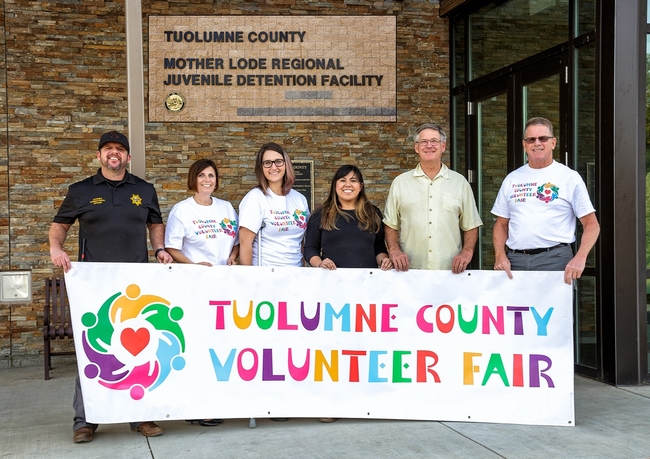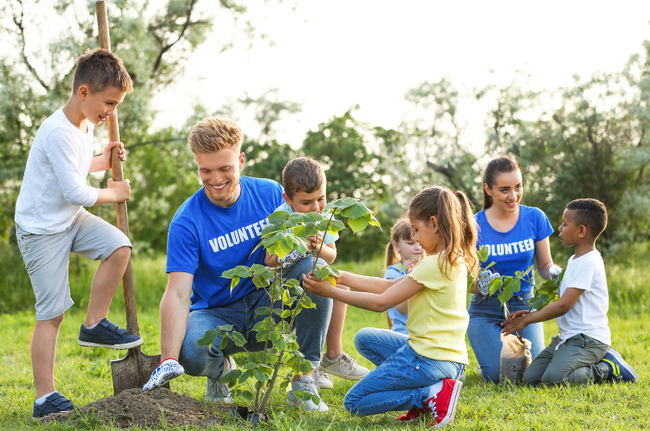- Author: JoLynn Miller
Volunteering may be the answer to bringing people together, in a time where there seems to be more division than ever. The Census Bureau and AmeriCorps report that while formal volunteering rates have declined, informal volunteering rates have remained steady. Last year, I discussed the many personal benefits to volunteering (longer lifespan, potential job skills, increased self-confidence, etc.). This year as National Volunteer Month comes to a close, I suggest looking at it from a different angle.
By volunteering, formally or informally, you are strengthening our community. We build social capital together. Dr. Nathaniel, a 4-H Advisor in Los Angeles county and researcher of social and community capital, writes, “Youth who are engaged in community service tend to have higher degrees of social capital. That is, youth who are engaged in at least 5 community service projects where they are involved with the conceptualization, design, planning, and execution of a community service project are more connected to community networks, resources, and institutions.” Furthermore, Dr. Worker, a 4-H Advisor in Marin, Sonoma, and Napa counties, found that besides skill development, increased well-being, and gratification from working with youth and other adults, 4-H volunteers strengthened social development, including developing friendships, strengthening family connections, and ties with the broader community.
As a life-long volunteer myself, I have experienced these things firsthand. Over the years, in four different communities, I've spent time volunteering as a way to make connections and learn about my neighbors. Some highlights have been teaching Red Cross First Aid and CPR classes, starting a livestock evacuation team, and being a foster dog mom. In each instance, I've met people with similar interests and passions for making a difference, and even formed lasting friendships. I also learned many of the people working side by side with me had different political views, different religions, and/or different worldviews. And it didn't matter where we differed because we were able to focus on the task at hand. Helping where help was needed.
Whether it be teaching a child about robotics in 4-H or helping animals find their fur-ever home, when you volunteer for a community organization that you're passionate about, you are inevitably making connections to others with the same goal in mind. When you're out picking up trash with a stranger, you're able to join forces, start a task, enjoy each others company while working, and feel accomplished together when the work is complete. Volunteering has the potential to break down the walls between us. It can bridge the gaps.
As the nation sees volunteer rates decline, I implore youth and families to find volunteer opportunities within their community though 4-H or otherwise. The services many non profits provide wouldn't be possible without volunteers; services the community has come to rely on-like food assistance, youth activities, veterans' services, fire and disaster safety, and more. Remember that not only will you be helping fill a specific need in the community, you'll also be building a strong one.
JoLynn Miller is a 4-H Youth Development Advisor with University of California Agriculture and Natural Resources. She is responsible for four counties in the Central Sierra and focuses her research on volunteerism, volunteer development, youth retention, and working with youth in the juvenile justice system. You can contact her at 209-533-5686 or jlmiller@ucanr.edu.
- Author: Russel Hill
The Benefits of Volunteering
Volunteering with 4-H can be a rewarding experience that not only helps young people but also benefits the volunteers themselves. Science, technology, engineering, and mathematics (STEM), healthy living, leadership, and civic engagement are but some of the broad categories of hands-on learning experiences that 4-H provides under the umbrella of positive youth development. Here are some of the benefits of volunteering with 4-H:
1. Making a Positive Impact
Volunteering with 4-H allows you to make a positive impact on young people's lives. By sharing your knowledge and skills, you can help youth develop new skills and interests. You can also serve as a role model and mentor, helping youth build confidence and self-esteem.
2. Developing New Skills
Volunteering with 4-H can help you develop new skills and knowledge. As a volunteer, you may have the opportunity to learn about new topics or gain experience in areas such as teaching, public speaking, and leadership. These skills can be valuable in your personal and professional life.
3. Building Networks
Volunteering with 4-H can help you build new networks and connections. You can meet other volunteers who share your interests and values, as well as connect with community leaders and professionals. These connections can help you build your personal and professional network.
4. Having Fun
Volunteering with 4-H can be a fun and rewarding experience. You can participate in hands-on activities, attend events and workshops, and interact with youth who are enthusiastic and eager to learn. You can also develop new friendships and enjoy the camaraderie of working with other volunteers.
5. Making a Difference in Your Community
Volunteering with 4-H allows you to make a difference in your community. By helping young people develop skills and knowledge, you can contribute to the well-being of your community and help create a brighter future for everyone.
6. Science Backs the Benefits of Volunteerism
- According to a study published in the Journal of Personality and Social Psychology, volunteering can enhance well-being and reduce symptoms of depression. [1]
- A report from the Corporation for National and Community Service found that volunteering can improve job prospects and increase employability. [2]
- A study published in the Journal of Health Psychology found that volunteering can lead to a sense of purpose and meaning in life. [3]
- According to a report from the National Conference on Citizenship, volunteering can promote social connectedness and increase civic engagement. [4]
- A study published in the Journal of Gerontology found that volunteering can improve physical health and increase longevity. [5]
7. Examples of Volunteering in 4-H
- Leader: As a leader volunteer, you can lead a 4-H project or activity in your area of expertise. This could involve teaching youth about animal husbandry, gardening, or robotics, for example. You would work with a group of youth on a regular basis, helping them develop skills and knowledge in your area of expertise. If you have a specific skill or interest, you can volunteer to lead a 4-H project. This could involve organizing a workshop or event, or providing guidance and support to youth as they work on a project. For example, if you are a skilled chef, you could lead a cooking project and teach youth how to cook their own meals.
- Mentor: As a mentor, you can work one-on-one with youth to help them develop skills and interests. This could involve providing guidance and support as they work on a project or helping them develop leadership skills. You would work closely with a youth over a period of time, providing ongoing support and encouragement.
- Judge or Evaluator: If you have expertise in a particular area, you can volunteer to serve as a judge or evaluator for 4-H events. This could involve judging a livestock show, evaluating a science fair project, or providing feedback on a public speaking contest. You would use your expertise to provide feedback and support to youth as they participate in 4-H events.
- Event Volunteer: You can also volunteer to help at 4-H events. This could involve setting up and taking down equipment, helping with registration, or serving as a chaperone. You would work with other volunteers to ensure that events run smoothly, and that youth have a positive experience.
These are just a few examples of the many ways you can volunteer with 4-H. No matter what your skills or interests are, there is likely a way for you to get involved and make a difference in the lives of young people. Volunteering with 4-H can be a rewarding experience that offers many benefits. If you are interested in volunteering with 4-H, contact your local 4-H office to learn more about opportunities in your area.
Sources:
- https://psycnet.apa.org/record/2010-09305-015
- https://www.nationalservice.gov/sites/default/files/resource-library/employment_impact_of_volunteering.pdf
- https://journals.sagepub.com/doi/abs/10.1177/1359105317695852
- https://www.ncoc.org/sites/default/files/NCOC%20Volunteering%20and%20Civic%20Life%20in%20America%20Report_0.pdf
- https://academic.oup.com/gerontologist/article/38/5/569/654051
- Author: JoLynn Miller
Last month was National Volunteering Month and as a wrap up, here are some amazing things about volunteering you may not have known!
History of Volunteering
Volunteering is part of the fabric of our nation. From the very beginning, community members banded together to help each other out. One of our founding fathers, Benjamin Franklin, started the first volunteer firehouse in 1736 and other efforts followed, often in support of the Revolutionary War. In the 1800s religious organizations fed the homeless and helped those less fortunate. Also, in the 1800s many well-known organizations were formed. These include the YMCA, American Red Cross, and United Way. During the 1900s volunteering increased with organizations like Rotary, Lions Club, and Kiwanis. Many of these volunteer organizations were focused on helping people in need, but youth serving organizations also got their start in the early 1900s; organizations like 4-H, Camp Fire Girls, Boys and Girls Clubs, Girl Scouts, and Boy Scouts.
Current Trends
Nationally, and in California, volunteer rates increased during the 1970's, 80's, and 90's. Numbers hit a peak in the mid-2000s. Over the last ten years, those rates have remained steady or slightly dropped. In 2021, over 5.5 million formal volunteers contributed 379.2 million hours of service through organizations, with an estimated worth of $13.5 billion (Americorps.gov). This equates to roughly 18.3% of California residents who formally volunteered through organizations. Over 46.1% of residents report doing a favor for a neighbor which is a type of informal volunteering. Virtual volunteering increased prior to and during the pandemic. It allows community members to help organizations even when they are not in town. Things like accounting, writing newsletters, website design, or social media are all jobs volunteers can do virtually and on their own schedule.

Benefits to YOU
Did you know you might live longer if you volunteer? The Mayo Clinic cites research that shows volunteering leads to improved physical and mental health. In addition, in 2005 a longitudinal study showed folks that volunteer live longer than those that don't.
Volunteering could serve as a path to employment, not only for teens and young adults, but for those re-entering the workforce after time away. The Corporation for National and Community Service (CNCS) states that volunteers have a 27% higher chance of finding a job after being out of work compared to those not volunteering. If a person does not have a high school diploma, volunteering could increase their chance of finding a job by 51%! The CNCS reports that volunteers living in rural areas have a 55% higher chance of finding employment that non-volunteers. While the research didn't investigate why this may be true, there could be a variety of reasons. Volunteers get experience and skill-building within the organization. When you volunteer, you build connections with others who can vouch for your reputation and work ethic. In depth volunteering can and should be placed on a resume with the supervisor or volunteer coordinator listed as a reference. In a recent study by Worker et al (2020), California 4-H volunteers reported personal benefits of volunteering in five themes: Skill Development, Well-being, Sense of Gratification from Working with Youth and Adults, Social Development, and Deepening their Relationship with 4-H. This study describes the positive benefit volunteering with this organization had on the volunteer themselves.
Benefits to the Community
Research suggests that communities with strong volunteerism rates are stronger and more resilient overall. Community members who volunteer act as bridges bringing people together that may not have otherwise been connected. Local economy experiences positive effects when individuals receive professional development opportunities as part of their volunteer role. A 2012 report from the National Conference on Citizenship (NCoC) explained that an increased number and variety of nonprofit organizations in a community, along with positive community relationships, can help it to withstand unemployment in a recession. The NCoC states “for individuals who held jobs in 2008, the odds of becoming unemployed were cut in half if they lived in a community with many nonprofit organizations rather than one with a few nonprofits, even if the two communities were otherwise similar.”
A quick story.
Tuolumne County hosts a county-wide volunteer fair every year where they try to connect local citizens with volunteering opportunities. I had the pleasure of interviewing a participant that came to the 2018 fair and in 2019 started volunteering at the local juvenile hall via a community non-profit. Because of her great work at the juvenile hall, this volunteer was invited to a presentation by renowned child psychologist, Dr. Ross Green, hosted by the YES Partnership and Tuolumne Resiliency Coalition, titled: “Collaborative and Proactive Solutions: Understanding and helping children with social, emotional, and behavioral challenges. This ultimately led adding to coursework at Columbia College and she is now double majoring in Psychology and Allied Health. Because of this volunteering opportunity, she feels better able to take initiative and has been able to push out of her comfort zone. “Since the Volunteer Fair, things in my life have just lined up.” She credits her attendance at the Volunteer Fair and subsequent volunteering to her changing life's course.

What Next?
Continue to volunteer! Help others see the benefits of volunteering within 4-H and other organizations. We appreciate what you bring to the organization, and we hope you see the benefit too!
References:
Harris AH, Thoresen CE. Volunteering is associated with delayed mortality in older people: analysis of the longitudinal study of aging. J Health Psychol. 2005 Nov;10(6):739-52. doi: 10.1177/1359105305057310. PMID: 16176953.
Worker, S.M., Espinoza, D.M., Kok, C.M., Go, C.G., Miller, J.C. (2020) Volunteer Outcomes and Impact: The Contributions and Consequences of Volunteering in 4-H. Journal of Youth Development. Vol 15 (4). DOI 10.5195/jyd.2020.847
https://www.mayoclinichealthsystem.org/hometown-health/speaking-of-health/3-health-benefits-of-volunteering



